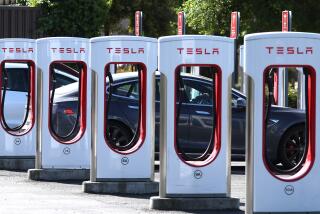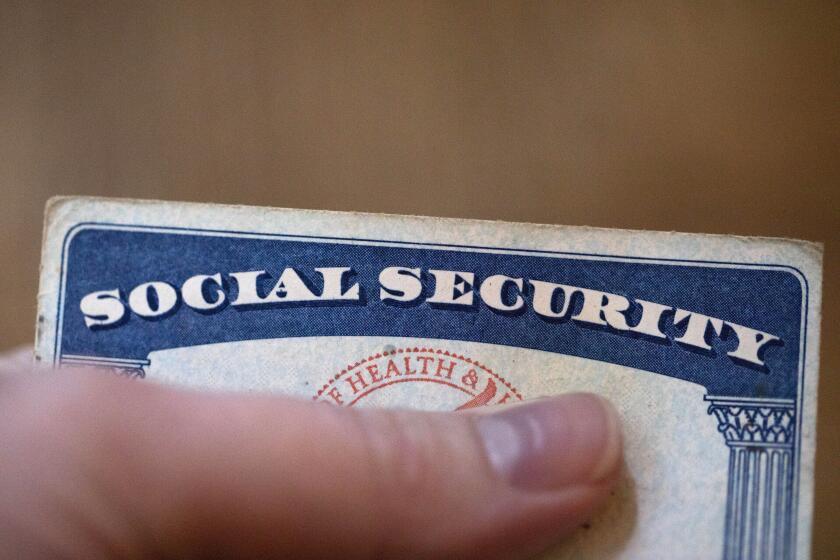Falling gas prices may boost the U.S. economy
For the first time in four years, Los Angeles drivers are paying less than $3 on average for a gallon of gasoline, part of a nationwide free-fall in fuel prices that could provide a substantial boost to the economy.
Because they’re spending less at the pump, Americans are expected to shell out more on holiday gifts, parties and travel this year. Airlines are projected to pass some of their fuel savings along to consumers next year. Businesses with previously hefty fuel bills may find room now to lower prices or increase wages.
“It’s a big plus for the economy,” said Mark Zandi, chief economist at Moody’s Analytics.
If gas prices stay low, Zandi estimated that U.S. consumers could find an extra $100 billion in their wallets next year compared with this year. “It could make the difference between a good year and a great year.”
For real estate agent Amber Dolle, lower totals at the service station are a welcome sight.
Dolle figures she spends more time in her Subaru Forester than in her office, zipping around the San Fernando Valley to preview and show homes. The stop-and-go of city driving, she said, can eat into her budget, especially if a client doesn’t close on a house.
But now Dolle is pocketing extra cash, which she plans to spend on her children’s college funds and advertising for her real estate services.
“I can put more into my business, which hopefully turns into more money,” she said.
The average price for a gallon of regular gasoline dipped to $2.987 on Wednesday in the Los Angeles area compared with $3.651 a year earlier, according to AAA’s daily report on fuel prices at thousands of U.S. service stations. The last time the L.A. average was less than $3 was October 2010.
The U.S. average price was $2.639 on Wednesday. Californians usually pay more at the pump than drivers in other states because of the state’s mandated cleaner-burning fuel, which is more expensive to make and is produced by few refineries outside California.
Gasoline prices are declining because of sharply lower worldwide oil prices, which have been driven lower by a North American shale oil boom and sluggish global economies. The combination has increased supplies and depressed demand.
The petroleum industry balance has shifted so much that ExxonMobil this week forecast that North America, long reliant on foreign oil, will be a net exporter of oil and other liquids by 2020.
But falling oil prices aren’t entirely rosy.
The Dow Jones industrial average fell 268.05 points Wednesday because investors were worried that lower oil prices were a signal that global economies were weaker than expected.
If faltering economies in other countries start to imperil the U.S., that could wipe out any benefit from less expensive fuel, said Nicholas Colas, chief market strategist at ConvergEx Group in New York.
“You root for higher commodity prices,” he said.
The oil price plunge isn’t good news for producing countries and many energy firms, including those in the U.S. that employ thousands of people, such as in the shale oil fields of North Dakota; they could take a hit and cut back production.
On Wednesday, crude oil prices plunged further after the Organization of the Petroleum Exporting Countries cut its forecast for global demand and the Saudi oil minister brushed off the idea of curtailing crude oil production.
West Texas Intermediate crude, the U.S. benchmark, fell $2.88, or 4.5%, to $60.94 a barrel on the New York Mercantile Exchange, the lowest since July 2009. The price has declined more than 40% since June.
Energy industry analysts said the most recent crude declines haven’t yet translated to the pump and there may still be room for crude and fuel prices to fall.
“At some of the price leaders ... I would not rule out $1.99 this winter in California,” said Tom Kloza, oil analyst for the Oil Price Information Service, a price-tracking service.
Among the benefits of lower oil prices could be cheaper air fares, something carriers have been reluctant to adopt so far.
The International Air Transport Assn. in Geneva said Wednesday that global fuel prices have dropped 33% over the last year. The trade group predicted that tough competition and stronger profit margins should result in fare drops of 5.1% in 2015 compared with this year.
Although it’s impossible to predict how long the fuel price declines will continue, most experts don’t see a return to $4 gas next year, even during the summer driving season when prices historically rise.
The federal government forecasts a gallon of regular to average $2.60 nationwide next year, compared with $3.37 this year.
The rapid plunge in gas prices will translate largely into spending rather than savings, because the greatest benefit will go to lower-income families, said William Dudley, president of the Federal Reserve Bank of New York.
Those families, which often live paycheck to paycheck, “have a higher tendency to spend any additional real income,” Dudley said last week.
For now, drivers are basking in a global oil glut.
Tina Moore on Wednesday filled up her black Toyota Corolla at a busy Arco station in Boyle Heights, costing her about $20 less than it would have during the summer.
The 42-year-old social worker said she might spend more on groceries and other items, while stashing some away for savings.
“I used to spend so much on gas, even with my small car,” she said.
But on Wednesday, a gallon of regular gasoline was only $2.77 at Arco’s pumps.
Shortly after she drove off, the price slipped 2 cents more.
Twitter: @khouriandrew
@parviniparlance
More to Read
Inside the business of entertainment
The Wide Shot brings you news, analysis and insights on everything from streaming wars to production — and what it all means for the future.
You may occasionally receive promotional content from the Los Angeles Times.











